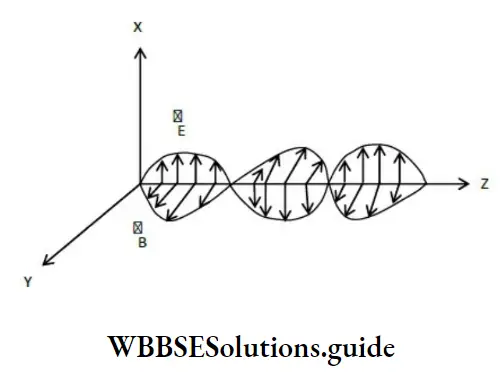Electromagnetic Waves
Ampere’s Circuital Law
Maxwell modified the Ampere’s circuital law \(\oint \overrightarrow{\mathrm{B}} \cdot \mathrm{d} \vec{\ell}=\mu_0 \mathrm{I}\) to explain the continuity of current in a circuit containing a capacitor.
⇒ \(\phi=\mathrm{EA}=\frac{\sigma}{\mathrm{s}_0} \mathrm{~A}=\frac{\mathrm{Q}}{\mathrm{A} \varepsilon_0} \mathrm{~A}\)
⇒ \(\frac{\mathrm{d} \phi}{\mathrm{dt}}=\frac{1}{\varepsilon_0} \frac{\mathrm{dQ}}{\mathrm{dt}}\)
⇒ \(\mathrm{I}_{\mathrm{d}}=\frac{\mathrm{dQ}}{\mathrm{dt}}=\varepsilon_0 \frac{\mathrm{dQ}}{\mathrm{dt}}\)
NCERT Summary of Electromagnetic Waves for NEET
This was the missing term suggested by Maxwell, which is called displacement current ID.
Read And Learn More: NEET Physics Notes
Displacement current is due to the rate of change of electric field between the plates of the capacitor
Conduction current and the displacement in a circuit may not be continuous but their sum is always continuous.
A modified form of Ampere’s circuital law / Ampere–Maxwell law is,
⇒ \(\oint \overrightarrow{\mathrm{B}} \cdot \mathrm{d} \vec{\ell}-\mu_0 \mathrm{I}+\varepsilon \mu_0 \frac{\mathrm{d} \phi_1}{\mathrm{dt}}\)

Electromagnetic Waves NEET Important Questions
Maxwell’s Equations
\(1. \oint \vec{E} \cdot d \vec{A}=\frac{Q}{e_0} (Gauss’ law of electricity)\)\(2. \oint \overrightarrow{\mathrm{B}} \cdot \mathrm{d} \overrightarrow{\mathrm{A}}=0 (Gauss’ law for magnetism)\)
\(3. \oint \overrightarrow{\mathrm{E}} \cdot \mathrm{d} \vec{\ell}=-\frac{\mathrm{d} \phi_{\mathrm{B}}}{\mathrm{dt}} (Faraday’s law)\)
\(4. \oint \overrightarrow{\mathrm{B}} \cdot \mathrm{d} \vec{\ell}-\mu_0 \mathrm{i}_{\mathrm{c}}+\mu_0 \varepsilon_0 \frac{\mathrm{d} \phi}{\mathrm{dt}} (Ampere – Maxwell law)\)
Representation of An Electromagnetic Wave:

& E_{\mathrm{z}}=\mathrm{E}_0 \sin (\mathrm{kz}-\omega \mathrm{t}) \\
& \mathrm{B}_{\mathrm{y}}=\mathrm{B}_0 \sin (\mathrm{kz}-\omega \mathrm{t})
\end{aligned}\)
Difference Between Mechanical and Electromagnetic Waves NEET
The direction of the EM wave is given by \(\overrightarrow{\mathrm{E}} \times \overrightarrow{\mathrm{B}}\)
\(\begin{aligned}\frac{\mathrm{E}_0}{\mathrm{~B}_0} & =\mathrm{c} \\
\mathrm{k} & =\frac{2 \pi}{\lambda}, \omega=2 \pi \mathrm{f} \\
\frac{\omega}{\mathrm{k}} & =\frac{2 \pi \mathrm{f}}{2 \pi} \lambda=\mathrm{c} \\
\mathrm{c} & =\frac{1}{\sqrt{\mu_0 \varepsilon_0}}
\end{aligned}\)
Best Notes for Electromagnetic Waves NEET Preparation
The velocity of light in a medium is given by,
\(\begin{aligned}& \mathrm{v}=\frac{1}{\sqrt{\mu \varepsilon}}=\frac{1}{\sqrt{\mu_0 \mu_{\mathrm{r}} \varepsilon_0 \varepsilon_{\mathrm{r}}}} \\
& \mathrm{v}=\frac{1}{\sqrt{\mu_0 \varepsilon_0}} \times \frac{1}{\sqrt{\mu_{\mathrm{r}} \varepsilon_{\mathrm{t}}}} \\
& \mathrm{v}=\frac{\mathrm{c}}{\sqrt{\mu_z \varepsilon_{\mathrm{r}}}}
\end{aligned}\)
The rate of energy transported per unit area by EM wave is given by,
Pointing vector, \(\overrightarrow{\mathrm{S}}=\frac{\mathrm{EB}}{\mu_0}=\frac{\mathrm{E}^2}{\mu_0 \mathrm{c}}\)
The energy density of the electric field is given by,
\(u_E=\frac{1}{2} \varepsilon_0 E^2\)Properties and Applications of Electromagnetic Waves NEET MCQs
The energy density of the magnetic field is given by,
\(\mathrm{u}_{\mathrm{B}}=\frac{\mathrm{B}^2}{2 \mu_0}\)- Average electric energy density = average magnetic energy density.
- The intensity of the EM wave is given by,
- The electric vector is responsible for all optical effects. This vector is also known as the light vector.
- The pressure exerted by an EM wave is given by,
- The momentum carried by an EM wave is given by,
